
The face ages in a somewhat predictable pattern, though at a different rate and to a different extent depending on multiple factors. Both genetics and lifestyle choices contribute to the aging process. A detailed understanding of the anatomy and how changes in anatomy lead to the sequelae of facial aging is required to make the most appropriate treatment recommendations. An individual’s aesthetic goals and specific concerns also need to be prioritized to provide optimal, natural results. The following is a concise description of what changes in the face and neck as we age. It is important to seek not only a fellowship-trained but also a double board-certified facial plastic surgeon if you have aesthetic concerns about your face and/or neck.
Aging Hair
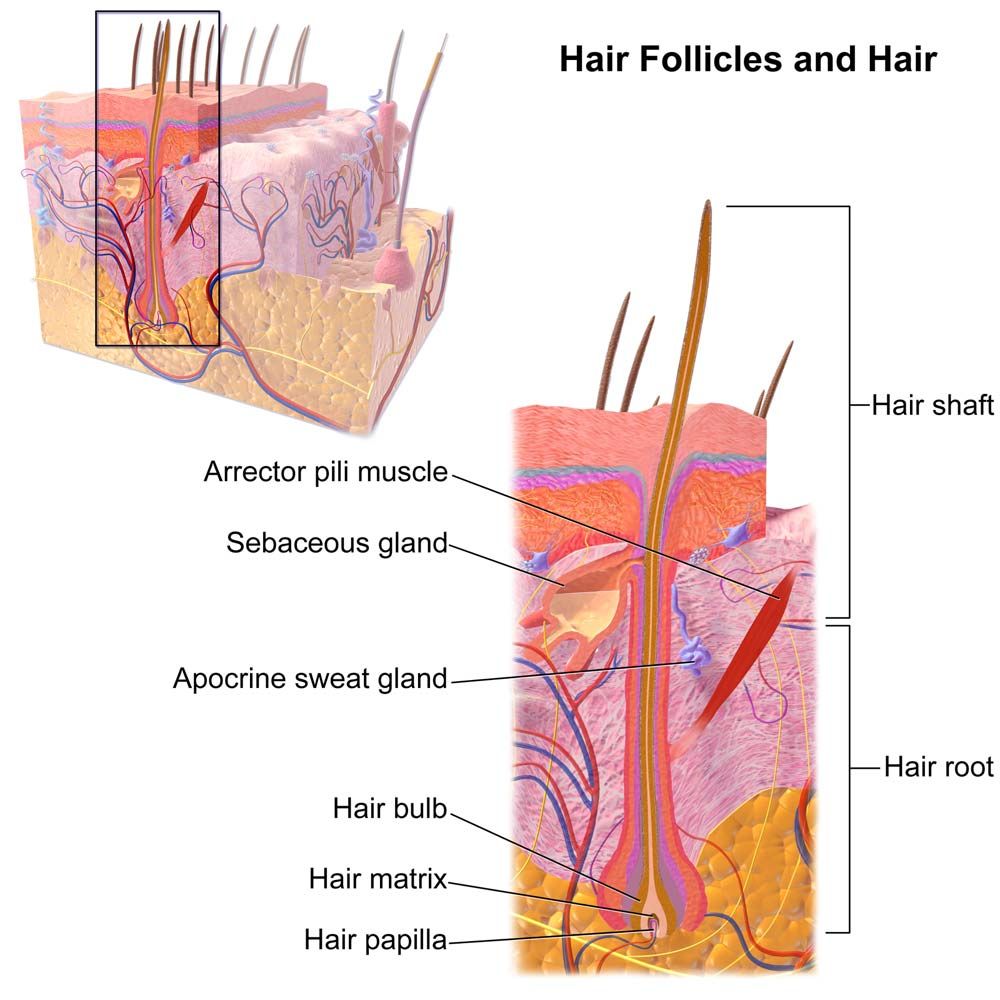
The hair is composed of groupings of hair follicles, which themselves are a complex of cells that function to grow hair and support that growth. The above diagram is an illustration of the anatomy of a hair follicle.
Hair follicles cycle through periods of hair growth, hair loss, and rest. This process occurs in everyone throughout their lives.
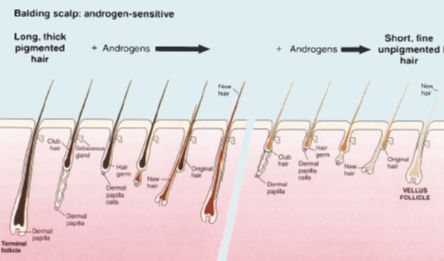
While there are multiple reasons why a patient may lose their hair, the most common cause is the action of a family of hormones called androgens on the function of hair follicles. Called androgenic alopecia, this condition can affect both men and women.
Androgenic alopecia results in hair in certain areas of the scalp shrinking and losing pigmentation. These hair follicles are eventually lost without being replaced. This process leads to balding. The diagram above is an illustration of what occurs to hair and hair follicles during balding due to androgenic alopecia.
The onset and pace of hair loss due to androgenic alopecia varies between individuals and is heavily influenced by genetics. However, the pattern of hair loss in men and women due to androgenic alopecia is somewhat predictable.
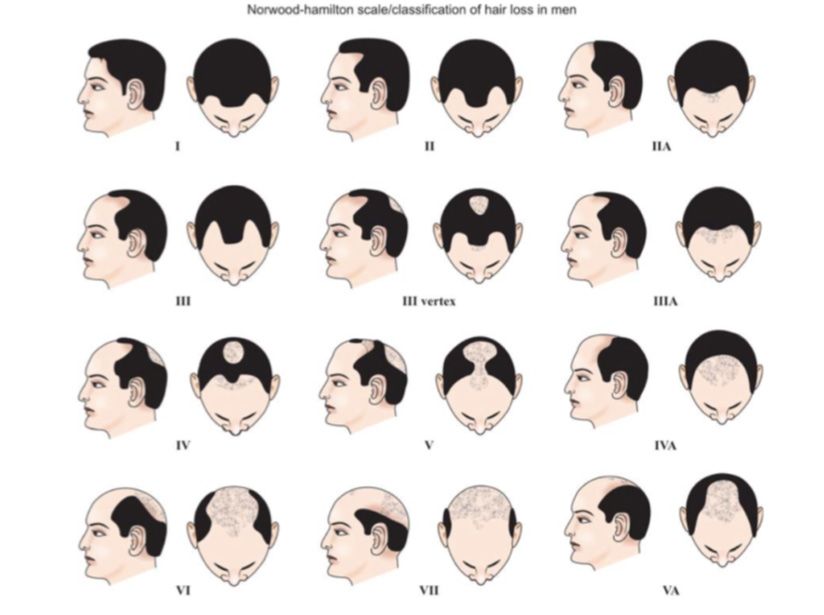
The pattern of hair loss for men has been described under the Norwood classification. The diagram above is a visual representation of the Norwood classification system and reflects the most common pattern of hair loss in men. Individuals progress in their hair loss starting at different ages and at different rates. Not all men progress to a Norwood VII classification.

The pattern of hair loss for women has been described under the Ludwig’s classification. The diagram above is a visual representation of the Ludwig classification system and reflects the most common pattern of hair loss in women. Individuals progress in their hair loss starting at different ages and at different rates. Not all women progress to a Ludwig III classification.
There are non-surgical and surgical treatment options available for both men and women who experience hair loss due to androgenic alopecia.
Aging Forehead
The forehead extends from the hairline to below the eyebrows at the rim of the eyes. It is composed of skin, muscle, and other soft tissue overlying the frontal bone of the skull.
A long, thin muscle, called the frontalis, extends over the forehead like a ribbon. It is the only muscle responsible for lifting the eyebrows. It is also the target of Botox© in the forehead. Other muscles of the forehead, including the orbicularis oculi, corrugator, and procerus, pull the eyebrows down. Botox© to the crow’s feet targets the orbicularis oculi. Botox© to the “11 lines” or “frown lines” between the eyebrows targets the corrugator and procerus muscles.
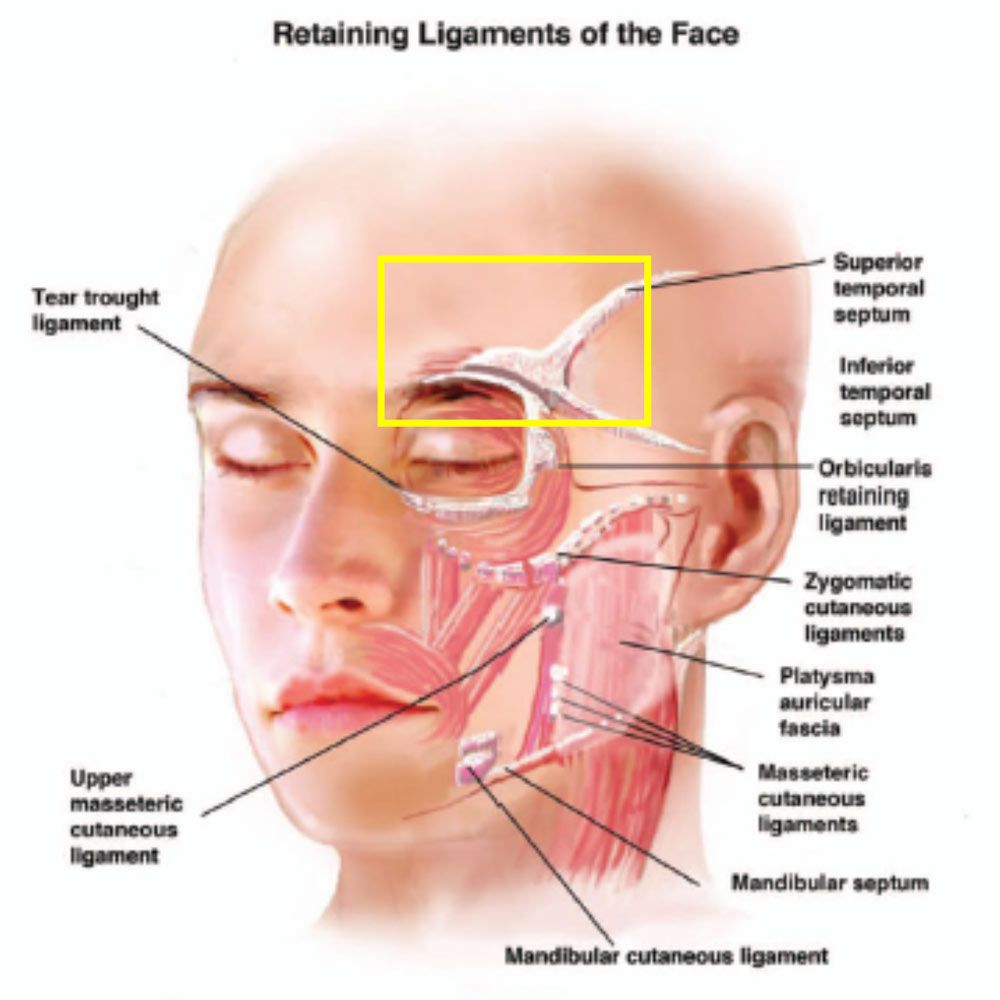
The eyebrows lie over strong ligaments that extend from bone to skin. That is illustrated in the above diagram outlined by the yellow box. A youthful eyebrow has a fat pad extending across it and over these ligaments.
The temple is composed of complex layers of skin, fat, fascia, and a muscle called the temporalis, which contributes to chewing.
The ligaments surrounding the eyes start to weaken with age, resulting in a drooping, or ptosis, of the eyebrows. While ptosis can occur across the eyebrows, it most commonly affects the lateral eyebrow resulting in “hooding” of the upper eyelid. Lateral eyebrow hooding can make you look sad or tired. A brow lift can treat these symptoms.
Fat is sometimes lost deep to the eyebrows and in the temples. This can hollow out the lateral portion of the forehead. If volume is lost in in this location, there are non-surgical and surgical procedures that can treat this.
Finally, wrinkles can develop on the forehead and between the eyebrows. The wrinkles can be present at rest, called static wrinkles, and be exaggerated with movement, called dynamic wrinkles. The treatment of static and dynamic wrinkles differs.
Aging Eyes

The upper and lower eyelids are composed of layers of the thinnest tissue in the face, though they contain skin, multiple muscles, fascia, and mucosa. Multiple fat pads populate the area around the eye. They are held back by a thin, fibrous tissue called the septum. The diagram above is an illustration of the complex anatomy of the upper and lower eyelids.
The skin loosens in the upper and lower eyelids with age, becoming redundant. Excessive upper eyelid skin can obstruct vision in extreme cases. Otherwise, this redundant skin results in significant wrinkling of the upper and lower eyelids.
The muscle deep to the eyelid skin can weaken and sag, most significantly in the lower eyelid.
The fat pads sitting behind the septum in the upper and lower eyelids push against the septum with age, resulting in eyelid bags.
Redundant skin, sagging muscle, and prolapsing fat behind the septum with age can result in a tired appearance. The most appropriate treatment for these changes is usually surgical.
Aging Face
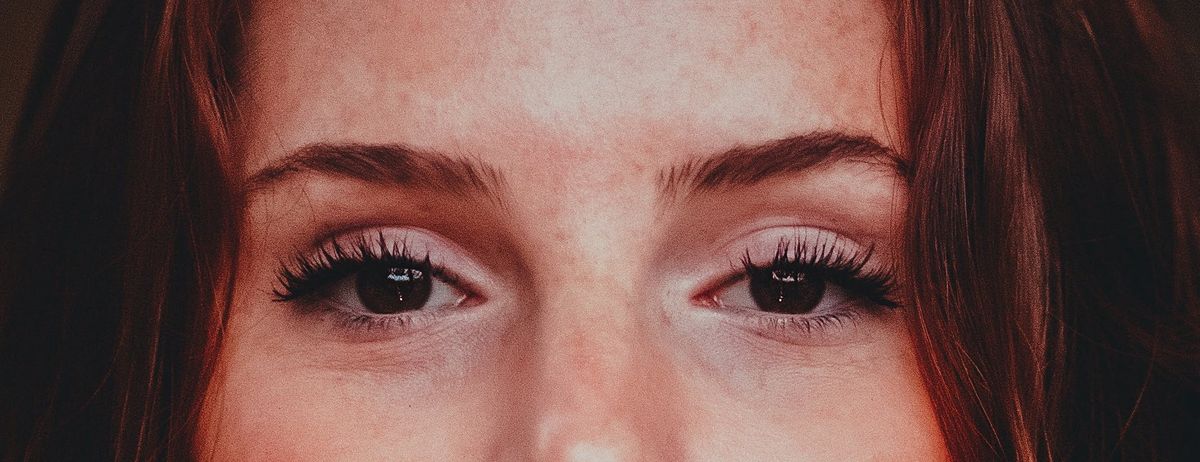
The lower two thirds of the face is a complex of skin, fascia, superficial fat compartments, muscle, deep fat compartments, and bone. A youthful face demonstrates smooth transitions between one area of the face to the other. The above image demonstrates a smooth transition between the lower eyelid and cheek in a young individual.
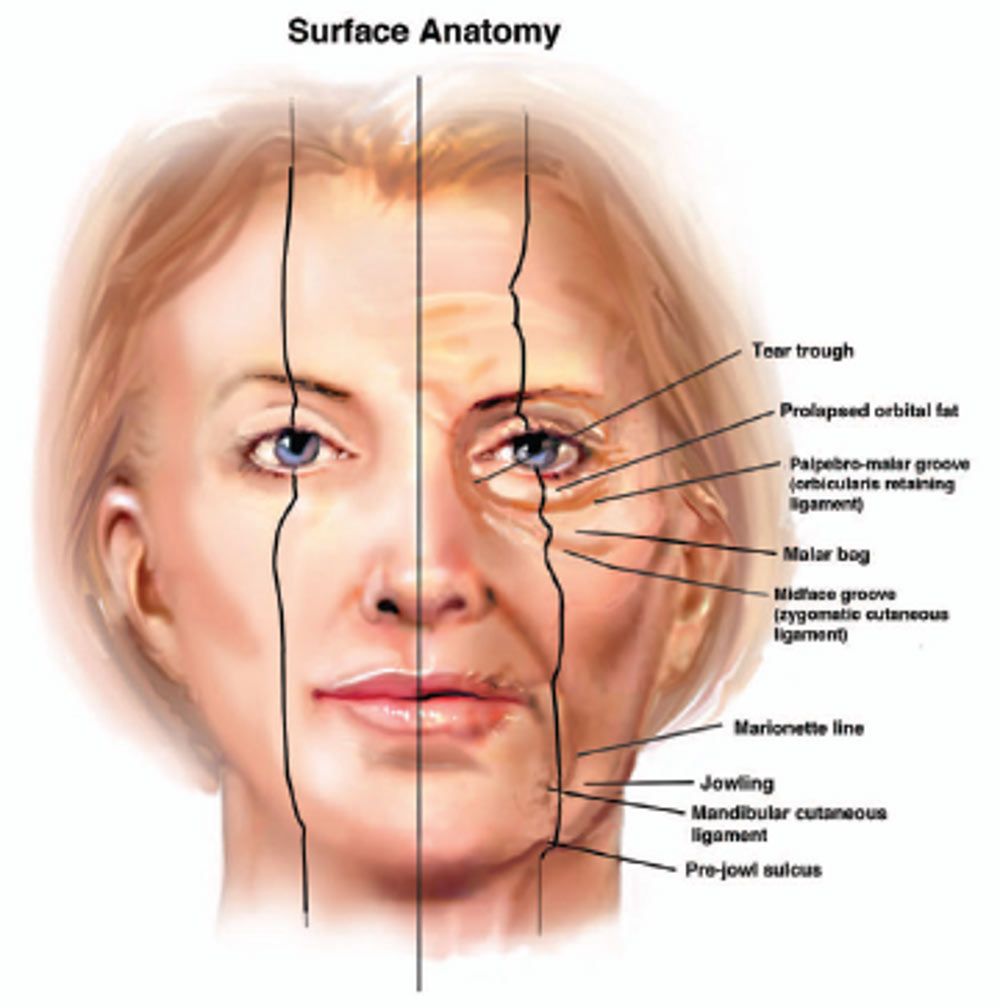
The loosening of skin and fascia as well as the weakening of tight ligaments surrounding the fat pads in the face results in drooping of the fat, mostly in the central face as indicated in the diagram below within the blue boxes. The result is a loss of a seamless transition between areas of the face, including the lower eyelids and cheek (tear troughs), the cheek and upper lip (nasolabial folds), and the cheek and lower lip (marionette lines). It is the sharpening of these borders and sagging of soft tissue volume in the face that imparts an aged appearance as demonstrated in the illustration above.
The overall result is a loss of a youthful heart-shaped appearance to the face and a more bottom-heavy face.
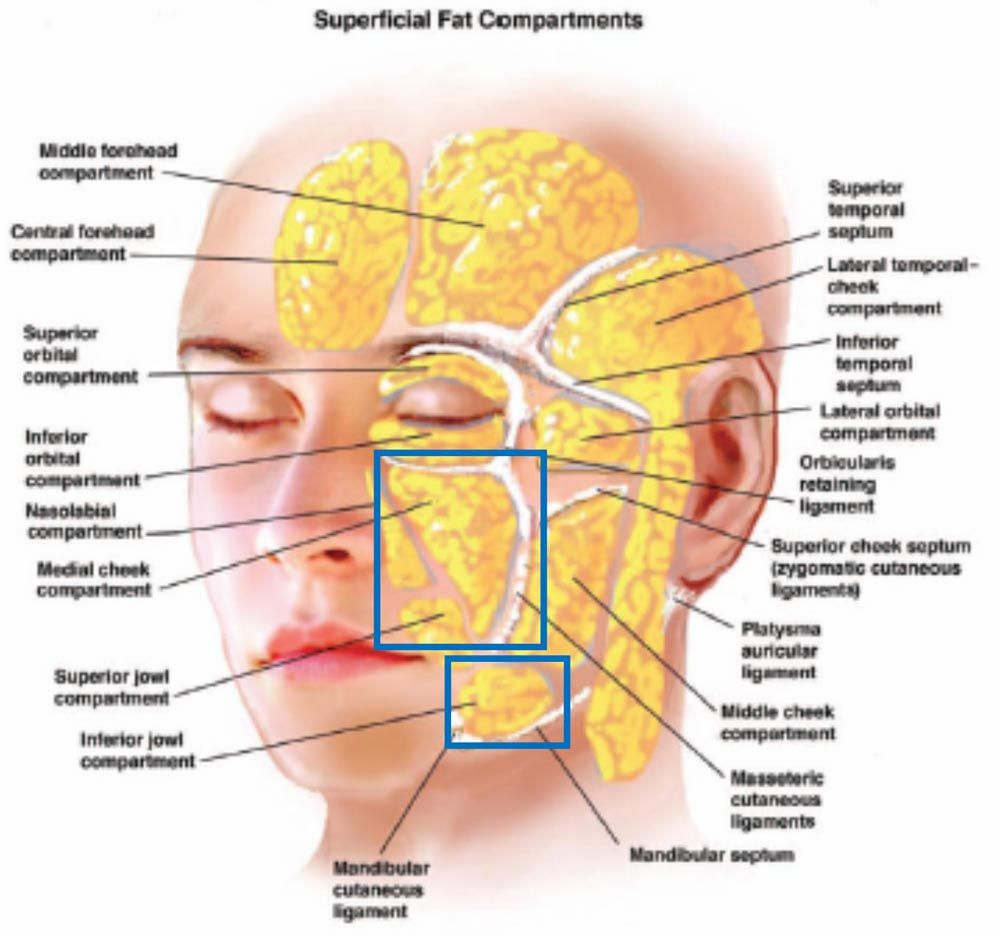
Other than the tear troughs, nasolabial folds, and marionette lines, some individuals develop a depression angled out and down across their cheek. This is a result of the cheek fat pad falling away from a prominence in the cheek bones.
While there are some non-surgical procedures that can improve the appearance of these depressions, only surgery can address the signs of aging of the lower two thirds of the face comprehensively.
Aging Lips
Often neglected by plastic surgeons, the lips age like the rest of the face.
The lips are composed skin extending from the base of the nose to the nasolabial folds and the red lip as well as the red lip itself. The lower lip includes not only red lip but also the skin between the lower lip, chin, and marionette lines.

As evidenced by the above illustration, there is little tissue between the skin and muscle surrounding the lip, called the orbicularis oris. The orbicularis oris muscle is in almost constant use when awake. As a result, deep wrinkles radiating out around the lips can develop. There are surgical options to treat these wrinkles, also known as smoker’s lines.
Not only does the lip skin wrinkle, but it also lengthens with age. The upper lip skin often lengthens while the red lip loses height and definition. The result is a loss of upper lip pout and a loss of upper tooth show when the lips are gently parted. There are non-surgical and surgical options to treat these changes.
Aging Neck
The neck is composed of multiple layers of skin, muscle, fat, fascia, cartilage, and bone. The most superficial muscle in the neck, called the platysma, extends from the clavicle bones over the jawline.
Skin loosens and sags with age. The platysma muscle weakens, most significantly at the midline, and sags with age as well. This results in thick, ropey bands in the center of the neck.
Loosening of the platysma muscle along the jawline contributes to jowls but also to a scalloping or blending in of the back corner of the jawline with the neck. The effect of the development of jowls and the scalloping of the jawline is a neck that appears shorter than it is.
Fat can accumulate under the jawline and in the neck immediate below the skin and deep to the platysma muscle. Severe excess of this fat can severely blunt the transition from the neck to the jawline.
The best treatment for the above changes to the neck is usually surgical.
Trust Your Face to a Facial Plastic Surgeon
It is important to seek a fellowship-trained specialist in plastic surgery of the face and neck when you have concerns about your face or neck.
Why Choose Dr. Harmon
- The mission of Harmon Facial Plastic Surgery is to help people along their journey towards self-confidence, to feel good about feeling good.
- Dr. Harmon is a double board-certified facial plastic surgeon.
- Dr. Harmon values making patients feel welcomed, listened to, and respected.
- Dr. Harmon graduated with honors from Cornell University with a Bachelor of Science degree in molecular biology.
- Dr. Harmon earned his medical degree from the University of Cincinnati.
- Dr. Harmon underwent five years of extensive training in head at neck surgery at the prestigious residency program at the University of Cincinnati.
- Dr. Harmon then underwent focused fellowship training in cosmetic facial plastic surgery through the American Academy of Facial Plastic and Reconstructive Surgery (AAFPRS) with the world-renowned surgeon, Dr. Andrew Jacono, on Park Avenue in New York City.
Request a Consultation
Request a consultation with Dr. Harmon at Harmon Facial Plastic Surgery in Cincinnati. Visit our clinic. You will learn more about Dr. Harmon’s credentials, style, and approach. Build a relationship with our dedicated team. Do not stop at searching “plastic surgery near me.” Get in touch with us to learn more!
References
- Alghoul M, Codner MA. Retaining ligaments of the face: review of anatomy and clinical applications. Aesthet Surg J. 2013 Aug 1;33(6):769-82.
- Jacono AA. The Art and Science of Extended Deep Plane Facelifting and Complementary Facial Rejuvenation Procedures. Quality Medical Publishing Inc; 2021.
- Jacono AA, Bryant LM, Ahmedli NN. A Novel Extended Deep Plane Facelift Technique for Jawline Rejuvenation and Volumization. Aesthet Surg J. 2019 Nov 13;39(12):1265-1281. doi: 10.1093/asj/sjy292.
- Jacono AA, Bryant LM, Alemi AS. Optimal Facelift Vector and its Relation to Zygomaticus Major Orientation. Aesthet Surg J. 2020 Mar 23;40(4):351-356.
- Randall VA. Chapter 2: The Endocrine Control of the Hair Follicle. In: Blume-Peytavi U, Tosti A, Whiting DA, Trueb RM, eds. Hair Growth and Disorders. Springer; 2008: 23 - 39.
- Stuzin JM, Baker TJ, Gordon HL. The Relationship of Superficial and Deep Facial Fascias: Relevance to Rhytidectomy and Aging. Plastic and Reconstructive Surgery. 1992 Mar;89(3):441-9.
- Sykes JM, Riedler KL, Cotofana S, Palhazi P. Superficial and Deep Facial Anatomy and Its Implications for Rhytidectomy. Facial Plast Surg Clin North Am. 2020 Aug;28(3):243-251.
Disclaimer
This blog post is for educational purposes only and does not constitute direct medical advice. It is essential that you have a consultation with a qualified medical provider prior to considering any treatment. This will allow you the opportunity to discuss any potential benefits, risks, and alternatives to the treatment.
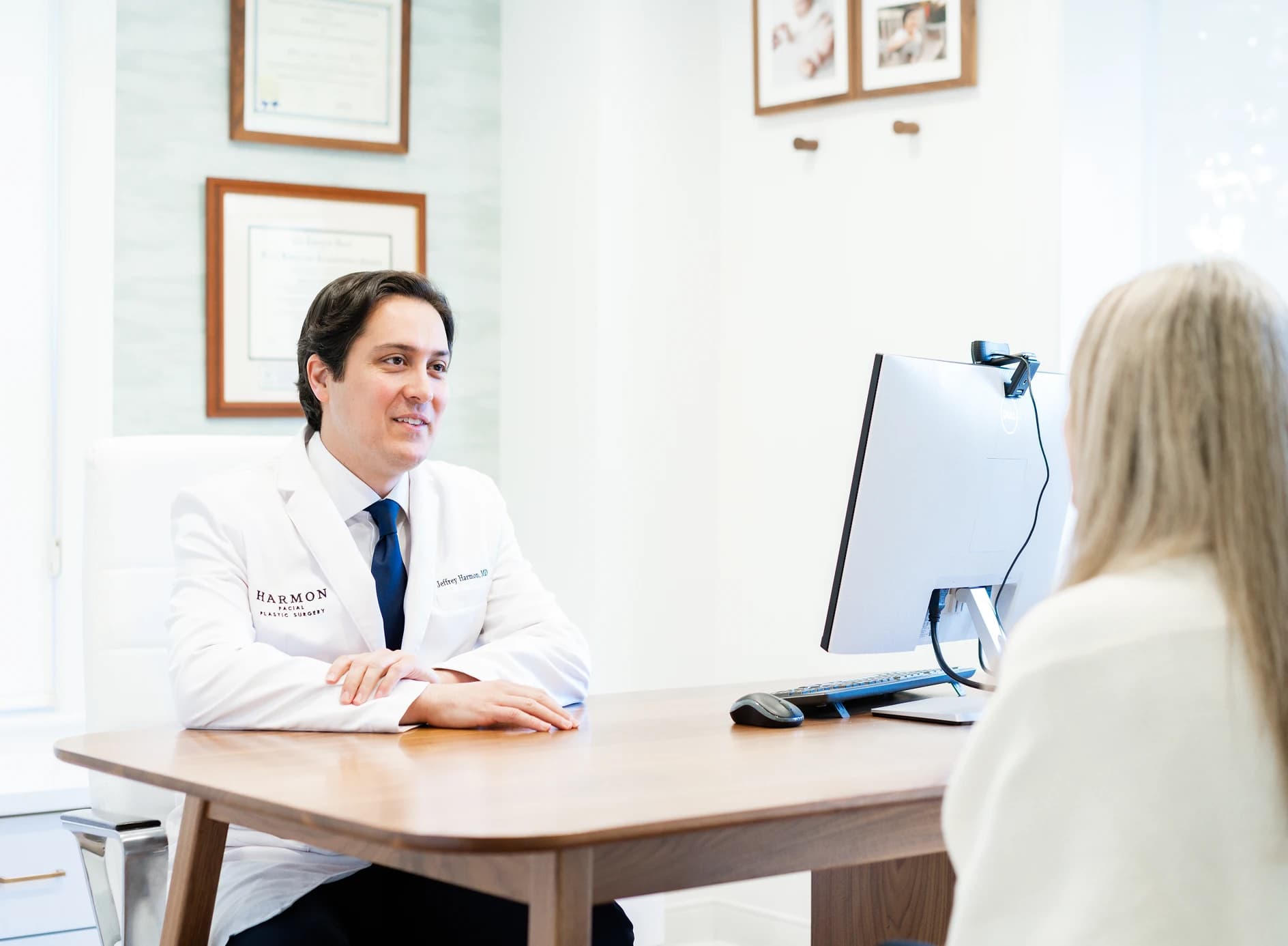
Book Your Consultation
Take the first step toward enhancing your natural beauty by scheduling a personalized consultation with Dr. Jeffrey Harmon. As a double board-certified facial plastic surgeon trained by the pioneer of the extended deep plane facelift, Dr. Harmon offers expert guidance and care. Whether you're considering surgical or non-surgical options, our team is here to support your journey to renewed confidence.